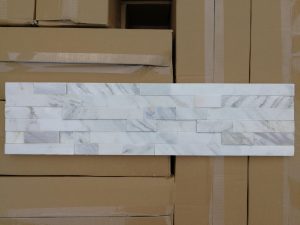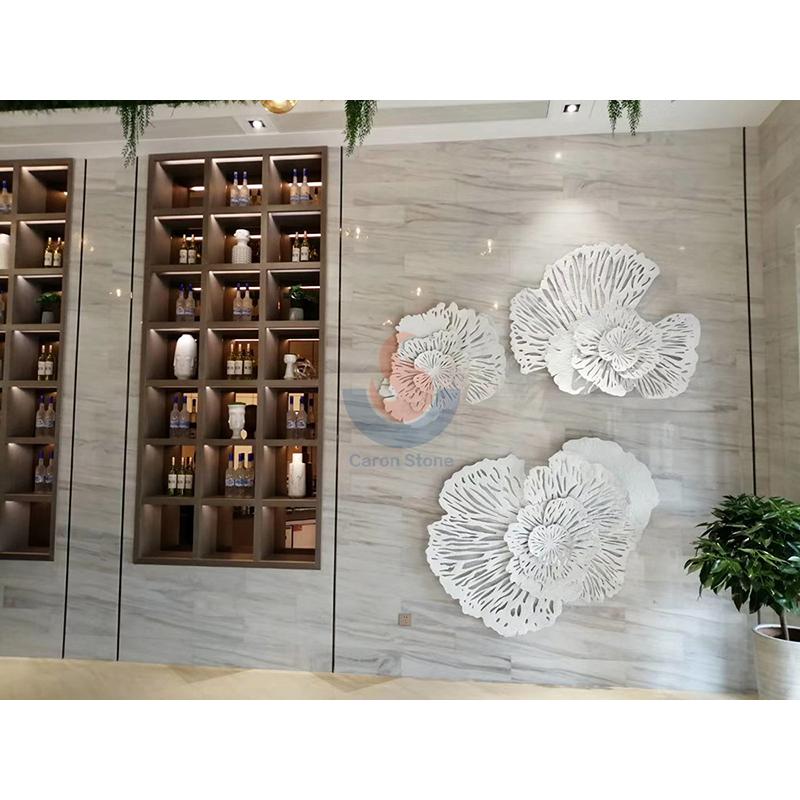Marble, a natural stone often known as the “gem of architecture”, is deeply loved by architects and designers for its unique texture and noble texture. Still, marble is not only aesthetically pleasing but also quite crucial for the building’s acoustic design. Acoustic design is an art that harmoniously unifies sound and space, and the role of marble in this may be beyond many people’s expectations. It is not only a decorative material, but also a key factor in adjusting the acoustic effect of the building space. What thus precisely are marble’s acoustic characteristics? In architectural acoustic design, how does it matter? This page will help you to discover.

Volakas Marble ,Greece white marble ,White marble split and Grooved face ledger stone panel, culture stone ,wall cladding ,stone veneer panel , stone wall decoration
Analysis of the acoustic properties of marble
1. Density of marble and sound wave propagation
The propagation of sound in a medium is closely related to the density of that medium. Marble, being a high-density natural stone, has a tight internal molecular structure that greatly affects the sound wave propagation. Marble is hard and non-porous, hence sound waves are reflected when they come into touch with its surface, even though high-density materials often allow them to move quicker inside them. Marble thus has very great sound reflection, which gives it special acoustic characteristics in architectural acoustic design.
2. Marble’s sound reflection and sound diffusion capabilities
Marble is perfect for sound wave reflection because of its high density and smooth surface. When sound waves encounter a marble surface, they are often reflected back into the space, increasing the sound energy within the space. Sometimes the acoustics of a space might be improved by this reflecting effect. Appropriate sound reflection, for instance, can improve the depth and clarity of sound in a theater or music venue. However, too much reflection can also lead to echoes and acoustic interference, so this needs to be handled carefully in building design.
In addition to its reflective capabilities, marble also has certain sound diffusion capabilities. Though this diffusion impact is less than that of specialized sound diffusion materials, in particular designs the natural texture and irregular surface of marble can help distribute sound waves, hence reducing the creation of echoes. This characteristic makes marble an ideal choice for both aesthetics and functionality in certain places with high acoustic requirements.
3. The sound absorption properties of marble
Marble has a weak sound absorption capacity compared to sound absorbing materials such as wood or fabric. Most of the sound waves will be reflected since the marble surface is smooth and solid; sound waves find difficulty to be absorbed on its surface. Therefore, in acoustic design, if marble needs to be used to decorate a large area of wall or floor, designers will often match it with other sound-absorbing materials to balance the acoustic effect of the space.
However, that doesn’t mean marble has no place in acoustic design. On the other hand, exactly because of its poor sound absorption, marble has become a necessary component in circumstances where sound reflection has to be improved. Marble can greatly improve the clarity and intensity of the sound field in halls, conference rooms or concert halls where strong sound effects are needed.
Marble’s architectural acoustic design application
1.Concert hall and theater acoustic design
In places such as concert halls and theaters, the propagation and reflection of sound directly affect the audience’s auditory experience. Usually using the highly reflective qualities of marble, designers apply it to locations including stage backgrounds, side walls or rear walls of the auditorium to produce an optimal sound field setting. The sound wave reflection in these areas can improve the penetration of sound, so that every detail of the performance can be clearly conveyed to the audience’s ears.
However, care also needs to be taken in the design to avoid excessive reflection of sound waves, especially in large spaces. Designers would thus employ innovative schemes to mix marble with other materials, such adding sound-absorbing panels to the ceiling or part of the wall, thereby lowering unneeded echoes and sound wave interference and so producing a more balanced acoustic environment.
2. Reception and luxury lobby acoustic design
Marble is often used for floor and wall decoration in luxury spaces such as hotel lobbies and company reception areas. Usually, these places demand specific acoustics to create a pleasant sound environment. In this case, the sound-reflective properties of marble help to enhance the sense of openness of the space, while also improving the clarity of sound, especially when speech is being spoken or music is playing in the background.
However, to prevent the sound from being too noisy or echoing, designers may incorporate some sound-absorbing decorative elements into the design, such as carpets, acoustic ceilings, or acoustic glass. These components, together with marble, maximize the acoustics and preserve the opulent atmosphere of the room.
3. Acoustic design of high-end residences
Marble is utilized in high-end residences for both decorative purposes and perhaps acoustic ones. Marble’s sound-reflective qualities, for instance, let designers of a home theater or music room maximize the wholeness of sound and the impression of space. In social areas such as living rooms or dining rooms, the sound diffusion capabilities of marble can help create a more open and active sound environment.
However, it is also important to note that using marble in a large area may make the sound in the space too loud. Thus, in home décor, soft sound-absorbing materials like wood and fabric are commonly mixed to attain superior acoustic effects.

Black Forest Wood Grain vein Marble Slab Prices Ancient Wood Grain Tree Marble
Marble is a “visual gem” in architectural adornment as well as a major component of architectural acoustic design. Marble may provide distinctive sound effects in acoustic design and improve the whole experience of the room with its great density, strong reflection and certain diffusion capacities. Of course, designers need to consider its low sound absorption properties when applying marble and combine it with other materials to achieve an ideal acoustic environment. In general, the clever application of marble in architectural acoustic design can not only demonstrate its aesthetic value, but also bring the artistic charm of sound to the architectural space.





